Description
- 【LIGHTWEIGHT AND ULTRA-THIN FOR EASIER MOVING】– This solar panel packs 110W of power yet is only 0.5inch (1.2cm) thick and weighs only 6lb (2.7kg),Foldable Dimension:21*20*1inch (54*50*2.4cm), making it easier to transport, hang, and remove.
- 【PERFECT CHOICE FOR OUTDOOR AND EMERGENCY LIFE】– 9.85ft (3m) cable length from panel to controller, For most power stations (Jackery,Goal Zero,Ecoflow,Paxcess) and 12-volt batteries(AGM,LiFePo4,Deep cycle batteries),RV,car,boat,trailer,truck,pumpa,camping,van,emergency power
- 【COMPLETE KIT,WORKS OUT OF THE BOX 】– Smart PWM charging Intelligent protection against reverse polarity, overcharging, short-circuit, and reverse current.Integrated 5V 2A USB ports to charge phones USB devices.If you use the built-in MPPT Power Station, you don’t need to connect the attached PWM controller.
- 【AFFORDABLE AND HIGH CONVERSION EFFICIENCY】– With high efficiency monocrystalline solar cell, you will get greater power efficiency even though the panel is smaller than a traditional model.Maximizes system output by reducing mismatch loss.
- 【QUICK DELIVERY+WARRANTY】– Amazon US warehouse shipping, Receive goods in time,All DOKIO products come with a 30-day money back Guarantee, 1-year warranty and forever support from DOKIO customer care.
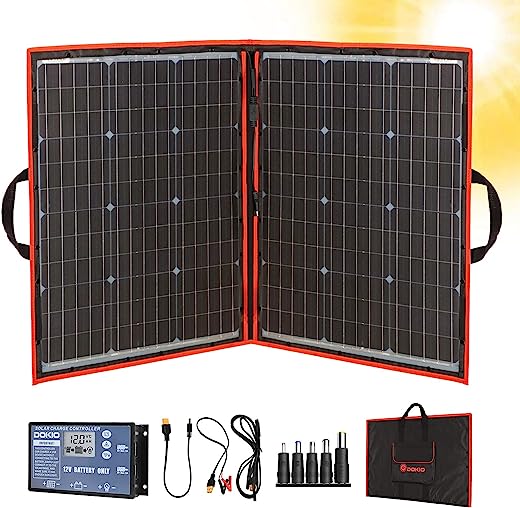
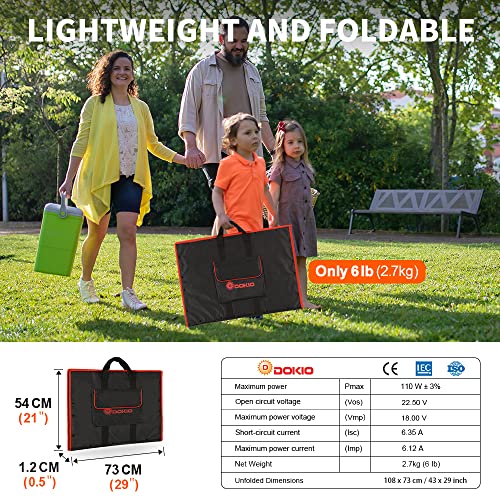
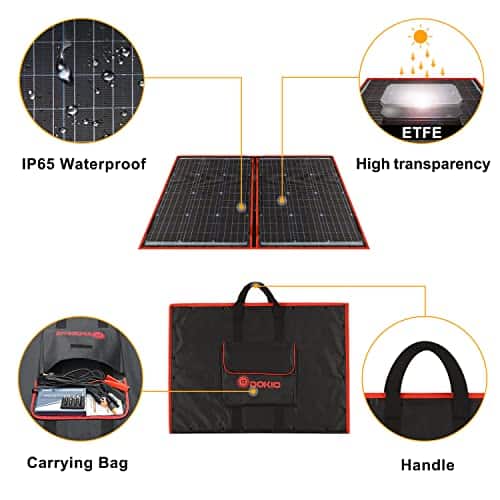
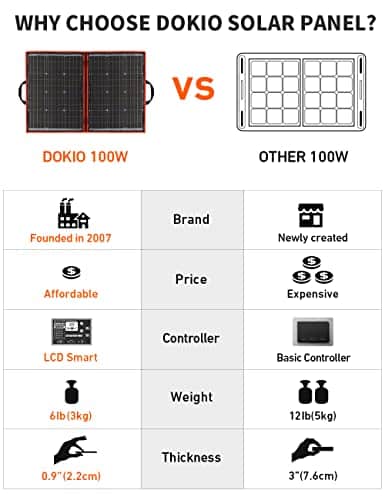
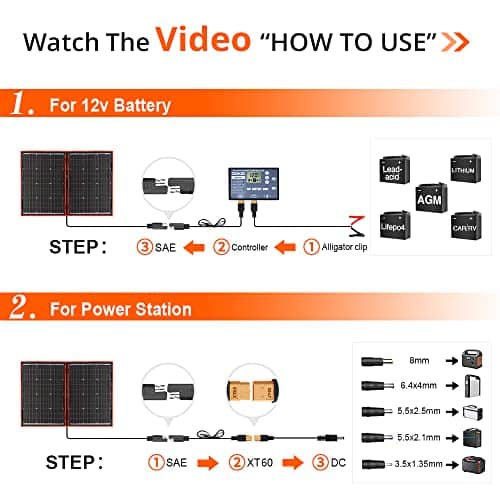
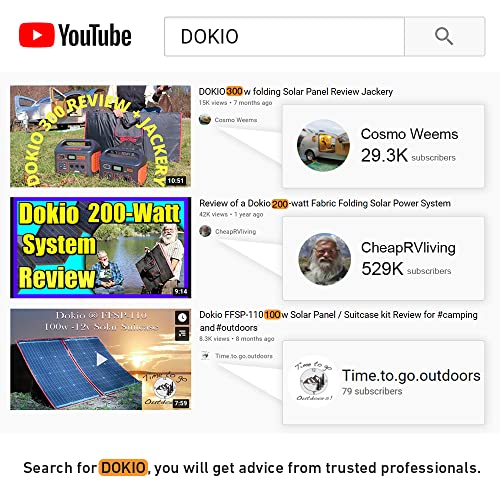
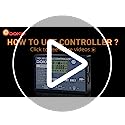
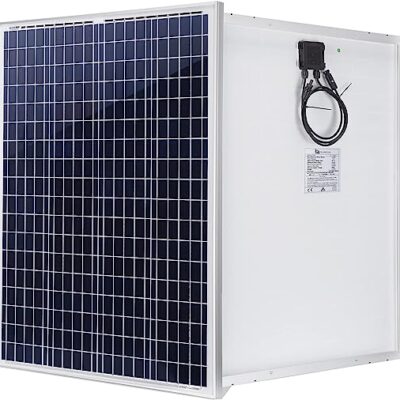
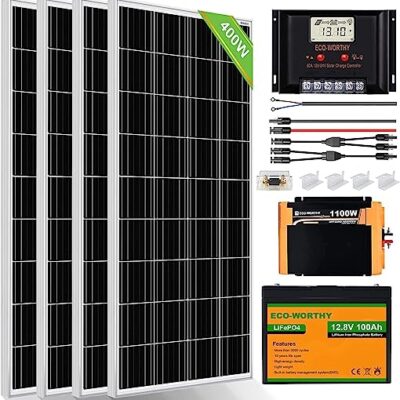
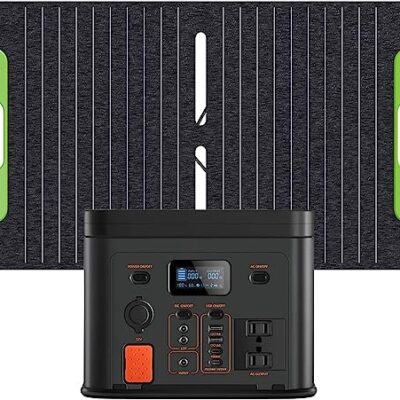
Big Joe –
11/06/2017 – Review updated to three stars
For my full original review, please read below. Would I buy them again? Yes, probably.
Only three stars due to the included charge controller. The included controller has the deficiencies described below in my original review. I will likely replace this controller with an MPPT controller.
I basically quite like the panels, their fold-ability, the canvas “package” they are mounted in, their light weight (about 11 pounds), and the fact that they fold down to a small 21” x 29” rectangle, less than 1” inch thick.
I have determined that the panels are working, thus the upgrade to three stars. When the panels are placed on plywood backing (the panels themselves are semi-flexible, so when tilted towards the sun on their own without the plywood support, they tend to flex, which means that the sun angle is then not optimum), on a cloudless day, I obtained the following readings (all readings using my digital multimeter – not with the included charge controller):
1. About 6 amps short circuit current (panels flat on the ground), then 8.5 amps short circuit current (on plywood backing, tilted towards the sun) out of rated max 11.36 amps short circuit current. Not sure why this is three amps short of the rated max – probably my sun angle tilting was not optimum. Will need to experiment further.
2. 20.6 volts open circuit voltage (out of rated max open circuit voltage of 22.5 volts).
3. 2.9 amps operating current (out of rated max 11.12 amps). I am assuming that this low operating amperage is due to the fact that my battery was nearing capacity.
____________________________
Where to start with this review?
I don’t actually hate them (I purchased the 200 watt version) – but I can’t seem to get these panels to work, and wish VERY much that I could. However, I am not (quite) ready to give up, as I really like the idea of folding panels, so (maybe) by posting this review I can get some assistance from Dokio, or maybe someone else who has purchased these panels.
If things change, I will definitely come back and update my review. At the moment I am quite disappointed, and am also out quite a few bucks over and above the cost of the panels (for all of the various “bits” that are needed for a solar system).
Firstly, the panels came very quickly, about two weeks after placing the order. The information on the packaging indicated that these panels came from China, so the speed of their delivery was quite impressive.
So far so good.
The package was double bubble wrapped, to the extent that it was even a bit difficult cutting though the bubble wrap to get at the actual box (a good thing!) The actual cardboard package within the bubble wrap was undamaged in any way.
In examining the panels, I was very impressed (and had high hopes!) that these panels would really fill the bill. I had spent years waiting, and literally tens of hours scouring the web for something like this. I travel in a converted cargo van, and needed something lightweight (so that I could easily lift them, as I have some age on me) and compact enough to store (the folded size was very attractive – easy to find a place to stow them in the very limited space inside my van).
I liked the way the panels were sewn into a kind of heavy-duty canvas fabric, with nice sewn canvas handles, and a convenient pocket to stow the charge controller. Very pleasing to the eye. I also liked the fact that there are small rings sewn around the edges of the panels, I assume that these rings could be used to connect the panels to some kind of tie-down. Especially nice were two usb ports in the charge controller.
The entire package seemed a compact and well made product, although there was a small divot in one of the panels that one could not see until the panel was put in direct sunlight, and the wiring that connected the charge controller to the battery is only about 12 or 14 gauge.
I travel and camp in my van, and have been wanting solar for many years so that I could run my Dometic ac/dc refrigerator, charge my cell phone and computer, and maybe run a few lights. At last (or so I was hoping) I would be able to boondock and avoid hefty campground fees (the kind that have electric hookups).
As I was waiting for the panels to arrive, I acquired three brand-new 75ah deep-cycle batteries ($200/ea – $600 total) that I planned to wire in parallel for 225ah, boxes to put them in, and had a battery isolator installed in my van ($225) so that I could charge the batteries while going down the road as well as when they were actually connected to the solar panels.
I decided to hold off on the rest of the bits and pieces of the install (the bits that would be on the load side) until I had the panels in hand and could verify that they worked as advertised.
It was when I opened the package, getting ready to whip these babies out into the sun, that I discovered the first problem.
The entirety of the “Users Manual” is printed double sided on a 5 ½ inch x 8 inch scrap of paper. About the size of a normal sheet of paper, if that sheet was folded in half. Since one side of this double sided manual is in Chinese, effectively the whole of the English-language owner’s manual is on one side of this tiny scrap of paper. I took a photo of the “manual”, and am including it below. Hopefully this is permissible under Amazon rules. You will notice on the photo that there was some kind of glue on the pages, so that when I opened the pages part of the information was lifted away, stuck to the glue, and thus unreadable.
Under the “Technical Parameters” heading there are several “model numbers” listed. I could not find that any of these model numbers corresponded with any similar number on either the charge controller nor on the panels themselves.
Under the “Display/Seeting” heading (what is “Seeting”? Darned if I know) there is an icon showing the factory-set start point of each of the settings (seetings?) that one can scroll through (see “LCD Display/Key” heading for scrolling information) but no explanation of how, why, when or even if any of these factory settings should be changed, or what, if any, effect that they will have on the system if they are changed.
Nothing.
I then spent about four hours in the hot sun trying to understand the extremely minimal information presented on the “manual”, with not a particularly good result. Since my batteries are not yet wired in parallel (was waiting to do the final wiring until I could see that the panels were working) I tried each battery, individually, three separate times.
Each time the charge controller appeared to work – somewhat (at least it lit up) – but at no time did the panel icon on the charge controller light, which would/should indicated that the panels were actually charging the batteries. The only icons that would come up was the battery icon pointing at the load icon.
The panel icon just never appeared.
When clicking on the buttons, sometimes the information on the controller would change, generally it would not. Even clicking on the button of the Main Menu generally it would work – but sometimes it would not. This may be because the holes punched in blue label on the front of the charge controller seemed as though they were offset from where the buttons needed to come through. They would kind of click when pushed, but with part of the blue plastic covering the button holes it may be that the clicking function was impeded by the label, keeping the buttons from fully extending. I thought about getting a razor blade and cutting the label so that the buttons were fully unimpeded (to see if that might help), but decided not to do this.
Although my batteries were bought new (directly from a battery retailer), the date of manufacture was May of 2017. Since, as of this writing (October 21, 2017) these batteries should have had some minimal discharge in the five months from May to October, so should have been able to accept some minimal charge. Again, never once did the panel icon ever show, indicating that the panels were actually charging. Only the battery icon and load icon ever showed during my testing.
Finally, at a loss of what else to try, I plugged my cell phone into one of the usb ports. My cell phone did indicate that it was charging – but my guess is that the charge was coming from the batteries, as the panel icon still did not light.
Thus still no definitive indication that the panels were actually working (charging).
Another problem is that the charge controller display only shows volts (i.e., under the heading on the manual “Display/Seeting [sic] – (I have no idea what “Seeting” is supposed to mean. Is it a typo,and actually means “setting”? Who knows), it does not show the flow of the current, i.e. how much current is flowing from the panels to the batteries (amps).
I guess I could purchase an additional display of some sort that would show amps, but this is just more money that I am not willing to spend at the moment. Anyway, at one point the controller showed 20v, when the panels were fully opened to the sun. I then folded the panels closed, one by one, and with only one (out of four) of the panels open to the sun, the controller still showed 19v. When I closed the final panel, the charge controller turned off.
To sum up, I would again like to say that I would very much like to see if these panels can be made to work. Their size, fold-ability, carrying weight, and wattage are just exactly what I have been searching for. However, I have tried just about everything I can think of to get these to work, and if I have to return them I will also have to (try) to return the batteries ($600) and will be stuck with the battery isolator ($225).
Thanks for reading. Comments appreciated. Help welcomed.
banjoist –
Connects easily, supports usb charging as well as 12V.
JSmith –
折りたたみのソーラーチャージャーが欲しく、値段が安くて軽かったこちらの商品を購入。ポータブルバッテリーの充電に使用しました。
80wということで、容量として足りるのかが不安でしたが、3月の晴天時で30wから40wの発電量で、庭仕事をしている間にしっかり充電できていました。そもそもポータブルバッテリーなので今のところ車中泊で使う程度であり、シガーソケットから充電(15wぐらいでした)もできるため、私としてはこのぐらいの出力で問題ありませんでした。
ちなみに私が使っているのはsu○okiのポータブルバッテリーですが、ソーラーチャージ用の端子がこちらのものと違っていましたので、ワニ口クリップを追加で一つ挟み、DCプラグで充電して使っています。直接繋いだらもっとたくさん充電できるかもしれません。
インジケーターも付いており、大変良い買い物をしたと思っています。耐久性も今のところ不安は感じていません。
ヤマさん –
Pour pompe de douche joolca
Happy camper –
This is just a nice paring of very lightweight panels and a easy-to-use controller. I was immediately able to use it to charge my phone (just for fun). Later I topped off the two 12v batteries on my camper trailer (success!). And then we had a big wind event which left our house without electricity for about 36 hours (we were lucky compared to others in our area). I used the setup to recharge our hotspots, phones, and some little portable batteries. So it actually helped in our situation.
Makes me want to get one of those larger charging stations to combine with the solar panels. Never ending cycle of gadgets.
よよよよよ –
The missing two stars on my rating is due to the lower output with ideal conditions. I can only get 59-63watts. Even with my upgraded cables. Second, no built in folding legs. You don’t realize how important this is until you’re looking for “anything “ to tilt this thing. If you’re looking for a decent 60w panel..ok. If you’re looking for a 100w. Look elsewhere.
Big Joe –
Update 2 years later…..i still have these. I use for camping. I put aluminim starps on the top then drilled a hole for a pad lock for to secure them while camping. Then used 30′ cable lock so that i can keep them secure when i go fishing or riding for the day or just leave them out for the 2 week at a time camping. I use a 40 amp renegy solar controller. The controllers that come with them are not for me. Im not getting the amps that i was when new but still about 21 amps with 3 pannels. Storing these in the storage carpartment of 5th wheel when not in use are a breeze to take out and get running in a few minutes. I see they make a stand for them which was not an option when i purchased. The stand is well worth it as i usually just lean them against 5th wheel or lay flat. Ends are fabric. Oh. I also use a bike alarm for each pannel to add that extra bit of security. Drive by night thefts of generators somtimes happen in az campgrounds. Also. Without a doubt. You will want to pair these with lithiumion phosphate bateries. Battleborn is the way to go. 10 year warrentry. The best deal ever. Only 18 pounds for 100aph battery. The prices are drooping. Buy USA. BATTLEBORN BATTERIES! You can purchase cheaper, but piece of mind that the battleborn batteries are less likly to potentially ignite are worth the extra price espically if you have a good amount of $$$$ investment in your trailer. Solid State batteries are still most likly several years away from consumers. Remember, lifeiPo batteries are real happy with a 14.4 charger specifically for LifeiPo. I also have a new thought about batery use now. Use them as a bank. If you take out 50 amps from a 100 aph battery, youll want to add 50 back in. So, do the math…20 amps per hour from 3 – of these solar pannels assuming full sun and other factors, cable length, connectors is about 3 to 8 hours to fully charge. Of course its all about volts and pairing with the right controller, bateries, charger, and battery management system ( i use victron with a bluetooth interface module) will maximize your resources and investment. Again….. Battleborn bateries is what made me rethink this whole solar use idea. They, Battleborn, will help you on pairing all your solar acessories with this awsome battery. Renogy has solar pannels too and in my tests, these flexible pannels are less expensive per watt and perhaps renogy makes a higher quality product, but these pannels have the fabric and plastic framing with handles and are sure less weight than other “camping” portable pannels, i think these pannels are only 14 pounds vs. 25+ pounds for the other manufacturers….
Orginal post….feb. 2021
wasnt too sure about reliability and quality. But. I have 3 of them and they do put out combined 32 amps, so about 10.5 amps each. All pannels are rated but in real world, they usually run about 75% of their rated watt n amps output with considerations of cable length and etc… so, i have deployed them with my 5th wheel for weeks at a time and im pretty impressed. I had high quity fixed ridged pannels which were too bulky and heavy and was getting only 18 amps total so these are very impressive so far. these flexible pannels are pretty darn good. I did use some 1/2 inch eyelets and used a 30′ masterlock cable set to enhance security and a security alarm for bikes and other security measures so the they dont wander off. But the cool thing is i can fold them up and store them under better security with little effort. Btw.. check out Battleborn lithium ion phospate 100amp/hr batteries to combine with your pannels. For me, its the only way to go if you like to have generator / electrical independance.. boondock camping with never any generator noise unless you want to run an air conditioner. Yay! Lifpo 4 batteries are the way to go anymore. This is just my opinion only and an honest review of these pannels with some info about a typical application.
Louie Pacheco –
未だ未使用ですがテストしたら発電はしています。冬に本格的に使うつもりで購入しましたが期待出来そうです。
二つ折りで持ち運びに良い感じです。